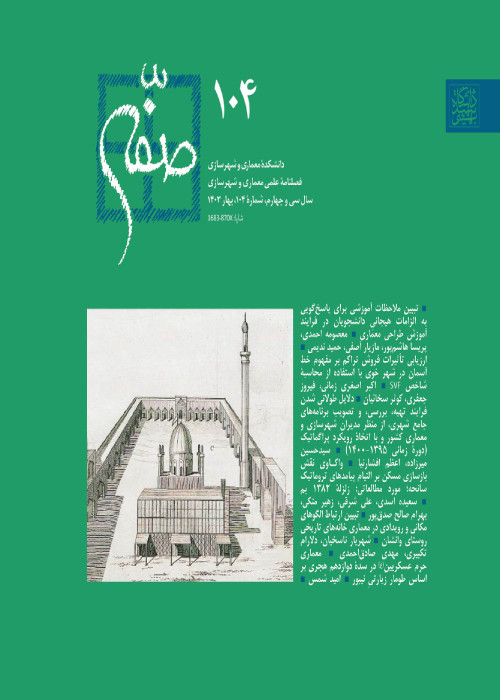Recognising Decorative Elements Taken from the West in Qajar Period Façades Using Close-Range Photogrammetric Technology: the Case of Window-Pediments in the Ahmad Shahi Pavilion
Author(s):
Article Type:
Research/Original Article (دارای رتبه معتبر)
Abstract:
The ornaments of the Qajar period reflect how Iranians adopted their approach to modernism from the West, and the way in which the architecture of this period was influenced by different architectural styles of the 18th - and 19th- century Europe. Influenced by European Rococo and Neoclassical styles, the Qajar Period is a time of change in Iranian architecture. An important type from this period is the residential pavilion in the middle of gardens with open views outwards. Here the role of window is changed from an element open to inner courtyard, to a façade looking towards the exterior garden. Therefore, an important architectural element reappears: the window-pediment. Investigating how Qajar architects used Western elements in ornamenting the facades of new buildings, this study has selected the 19th century Ahmad Shahi pavilion in Niavaran Palace, which contains 21 windows and two walls decorated with window-pediment. Using descriptive-analytical method and close-range photogrammetry as a system for data collection. The walls are carefully photographed together with their window-pediments, reproducing accurate façades with the help of Agisoft Metashape and orthophotos. Then, by comparing the facades, three types of forms were identified: simple triangular, scroll-shape broken and spiral-shape broken pediments. A precise lassfication of pediments, taking into account the characteristics of shapes and the filling texture of the pediment context, shows that there are 16 different types of pediments. There are similarities between paired pediments and those to the sides of arrays of three and five. The southern wall on either side of the decorative staircase is the most elaborate, with the apex of open, broken pediments crowned with the popular motif of the Qajar period, namely, flowers and vase. The research has concluded that creativity and improvisation in changing the shape of the pediments, the pattern of the ornamentation of the pediment chest and its filling texture using moulded, ornamented bricks is the distinguishing feature of the work of Qajar period architects.
Keywords:
Language:
Persian
Published:
Soffeh, Volume:33 Issue: 100, 2023
Pages:
119 to 137
magiran.com/p2542478
دانلود و مطالعه متن این مقاله با یکی از روشهای زیر امکان پذیر است:
اشتراک شخصی
با عضویت و پرداخت آنلاین حق اشتراک یکساله به مبلغ 1,390,000ريال میتوانید 70 عنوان مطلب دانلود کنید!
اشتراک سازمانی
به کتابخانه دانشگاه یا محل کار خود پیشنهاد کنید تا اشتراک سازمانی این پایگاه را برای دسترسی نامحدود همه کاربران به متن مطالب تهیه نمایند!
توجه!
- حق عضویت دریافتی صرف حمایت از نشریات عضو و نگهداری، تکمیل و توسعه مگیران میشود.
- پرداخت حق اشتراک و دانلود مقالات اجازه بازنشر آن در سایر رسانههای چاپی و دیجیتال را به کاربر نمیدهد.
In order to view content subscription is required
Personal subscription
Subscribe magiran.com for 70 € euros via PayPal and download 70 articles during a year.
Organization subscription
Please contact us to subscribe your university or library for unlimited access!



